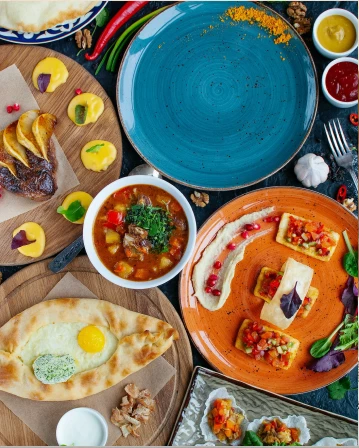Georgian cuisine is an essential part of the country’s cultural identity, and it reflects the diverse influences that have shaped Georgia’s history. With its rich flavors, unique ingredients, and hearty dishes, Georgian food is a culinary experience like no other. Some of the signature ingredients in Georgian cuisine include walnuts, pomegranates, herbs, and spices, while key dishes such as khinkali, khachapuri, and mtsvadi are renowned around the world. In this article, we will delve deeper into the diverse and delicious world of food in Georgia.

Traditional Dishes
Traditional Georgian cuisine is characterized by a rich variety of flavors and ingredients, including fresh herbs, spices, nuts, and fruits. Some of the most famous and popular Georgian dishes include khinkali, which are large dumplings filled with meat, vegetables, or cheese; khachapuri, a cheese-filled bread that comes in various shapes and styles; and lobio, a hearty bean stew often served with herbs and spices. These dishes, along with others such as chakhokhbili (chicken stew), pkhali (vegetable pâtés), and shashlik (meat skewers), are an essential part of food in Georgia and reflect the country’s culinary traditions and heritage.
Street Foods
Food in Georgia is not limited to fancy restaurants and home-cooked meals; it also encompasses a lively street food scene. Georgian markets and food stalls are known for their variety of snacks and treats, making it a foodie’s paradise. Some of the most popular street foods include churchkhela, a candy made from nuts and grape juice, and pkhali, a vegetable dish made from spinach, beets, or eggplant. Fried chicken is also a common street food in Georgia, often served with a side of tkemali sauce, a sour plum sauce. Whether you’re walking through a busy market or exploring a street fair, there’s no shortage of delicious and affordable street food options to try in Georgia.
Conclusion
In conclusion, exploring the vibrant food culture of Georgia is a delightful journey that unveils a myriad of flavors and culinary traditions. Georgian cuisine, renowned for its bold and distinct taste, offers a wide range of dishes that are sure to satisfy any palate. From savory khinkali and aromatic khachapuri to flavorful shashlik and refreshing pkhali, the diversity of food in Georgia is a true gastronomic adventure. For those interested in trying Georgian food, it is important to embrace the spirit of hospitality and conviviality that accompanies the dining experience. Sharing meals with friends and family, and engaging in lively conversations, is a cherished aspects of Georgian culture.

Georgia's flavorful cuisine delights taste buds with its rich culinary traditions.
Food in Georgia FAQ
Some famous Georgian dishes include khinkali (dumplings), khachapuri (cheese-filled bread), lobio (bean stew), chakhokhbili (chicken stew), pkhali (vegetable pâtés), and shashlik (meat skewers).
Some famous street foods in Georgia include churchkhela, a nut and grape juice candy, pkhali, a vegetable dish made from spinach, beets, or eggplant, and fried chicken served with tkemali sauce, a sour plum sauce.
Some signature ingredients in Georgian cuisine include walnuts, pomegranates, herbs, and spices.
CONTACT US FOR ANY QUESTIONS
Core responsibilities of Human Resource Management

Common Types of HR Services
3box. Culture and different internal policies all have a significant impact on employee retention and engagement. This extremely important for growing businesses and start-ups. For sustainable growth, a big-picture strategy managed by HR professionals or service providers will be key.
It is necessary to develop and maintain a systematized framework to discover opportunities and enhance work performance, while ultimately contributing to the betterment and value of the entity.
Stay ahead in a rapidly changing world
The solution WP consulting came up with combined cutting edge technology with real world practicality. Everyone knew that the systems had to be updated, the real challenge was updating them without disrupting the whole organization in a negative way. The solution was to introduce proper workload management done through computers, while providing mobile platforms to the stakeholders.
This allowed the workers to be involved in the job instead of feeling like they had been made redundant by technology.

The biggest challenge was that Arguzo was not utilizing technology properly. Too much of the work was still being recorded manually, which meant that the numbers took a long time to note down and then to be analyzed. Live data was also not available and decisions can only be made after all the required data and been received. This was holding Arguzo back; they knew they could corner more of the market if they had the ability to be more mobile. The work addressed three critical issues for Pharm Ltd.:
The biggest challenge was that Arguzo was not utilizing technology properly. Too much of the work was still being recorded manually, which meant that the numbers took a long time to note down and then to be analyzed. Live data was also not available and decisions can only be made after all the required data and been received. This was holding Arguzo back; they knew they could corner more of the market if they had the ability to be more mobile. The work addressed three critical issues for Pharm Ltd.:
The biggest challenge was that Arguzo was not utilizing technology properly. Too much of the work was still being recorded manually, which meant that the numbers took a long time to note down and then to be analyzed. Live data was also not available and decisions can only be made after all the required data and been received. This was holding Arguzo back; they knew they could corner more of the market if they had the ability to be more mobile. The work addressed three critical issues for Pharm Ltd.: